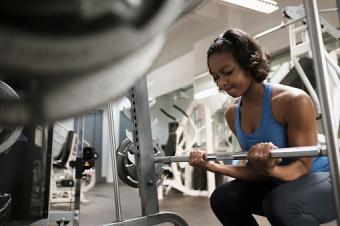
Whether it's been a while since you worked out or this is the first time you've considered improving your physical fitness, choosing to get healthy will benefit you now and well into the future, no matter how long it takes!
Depending on your current fitness level and other health considerations, getting in shape can take as little as 3-4 months as long as you work out consistently. Most people who follow a regular workout schedule and eat healthy foods will notice positive changes within 6-8 weeks.
Your Recipe for Getting in Shape
Getting in shape requires a combination of these five components of physical fitness. To get in shape - especially if you're new to exercise or have not exercised in a while - there are a few things you can do to set yourself up for success.
-
Work out 3-5 days a week, for at least 30 minutes each day
-
Set realistic goals
-
Track your progress
-
Include a mix of cardio exercises, resistance training, and flexibility exercises in your fitness routine
-
Eat a healthy, balanced diet
Remember to start slowly and gradually increase the intensity, duration, and frequency of exercise over time. It is also essential to get proper rest and to eat well to ensure your body has the fuel and energy it needs to support your new way of life.
The Five Components of Physical Fitness
Getting in shape offers obvious health benefits, and there are various ways to do it. To find a fitness program that is right for you, it's helpful to know the five components of physical fitness: body composition, cardiorespiratory endurance, muscular strength, muscular endurance, and flexibility. Each component plays an important role in your overall fitness and well-being, and they all affect how quickly you can get in shape.
Body Composition
Body composition refers to the proportion of fat to lean (muscle) mass in the body. Research shows that having a higher proportion of lean mass and a lower proportion of body fat can improve heart health, insulin sensitivity, and even cognitive function.
There are several methods to measure body composition:
-
Skinfold calipers: Involves using a tool to pinch the skin in specific areas of the body and measure the thickness of the skinfold. These measurements are then used to estimate body fat percentage.
-
Bioelectrical impedance analysis (BIA): Uses a small electrical current to estimate body composition. A BIA machine typically sends a current through the body and measures the resistance to the current, which is used to estimate body fat percentage.
-
Dual-energy X-ray absorptiometry (DXA): DXA is the most accurate way to measure body composition. It exposes the body to a low level of X-ray to estimate lean mass, fat mass, and bone mineral density.
-
Hydrostatic weighing: Also known as underwater weighing, it estimates body composition by measuring the weight of a person while submerged in water.
The American Council on Exercise (ACE) suggests that a healthy body fat percentage for women is between 21% to 31%, while for men it's between 14% to 24%. It's important to keep in mind that these are general guidelines, and factors such as muscle mass, age, sex, and genetics all play a role in determining healthy body composition ranges.
Losing body fat and gaining lean mass takes time, and there's no one-size-fits-all answer for how long it takes. It depends on your starting point, diet and exercise habits, and genetics. A 2016 study published in the American Journal of Clinical Nutrition reported that following a high-protein diet combined with an intense exercise regimen is more effective at improving body composition than eating a diet lower in protein.
Cardiorespiratory Endurance
Cardiorespiratory endurance, also known as cardiovascular fitness, refers to the body's ability to deliver oxygen and nutrients to the cells during physical activity. Activities like running, cycling, swimming, and brisk walking can improve cardiorespiratory endurance.
There are several ways to test your cardiovascular endurance:
-
VO2 max test: Measures the maximum amount of oxygen a person can breathe in during exercise. Considered the gold standard test for measuring cardiorespiratory endurance, they typically perform this test on a treadmill or a bike while wearing a mask to measure oxygen consumption.
-
Cooper test: Involves running as far as possible in 12 minutes. The distance covered can estimate VO2 max and determine your cardiovascular fitness levels.
-
Rockport walk test: Involves walking one mile as quickly as possible. Your heart rate is measured before, during, and after the test. Results can estimate VO2 max and cardiovascular fitness levels.
-
The step test: Involves stepping up and down on a bench or step for a certain period. Your heart rate is measured before and after the test, which can estimate your cardiovascular fitness level.
Research shows that moderate-intensity cardio exercises performed for 30 minutes, 5 days a week can lead to measurable improvements in as little as 4-6 weeks. Seeing significant improvements can take several months to a year of consistent exercise.
Muscular Strength

Muscular strength refers to the amount of force a muscle can produce with maximal effort. Think of the heaviest weight you can lift on a bicep curl or the max number of pounds you can hold while attempting just one squat. That's your muscular strength.
There are several ways to test your muscular strength:
-
One-repetition maximum (1RM) test: Involves finding the maximum amount of weight that can be lifted for a specific exercise, such as a bench press or squat, for one repetition. This test provides an accurate measure of maximal strength.
-
Isometric test: Involves holding a static position against resistance, such as holding a weight at a specific point during a lift, for a certain period of time, it can also be done against an immovable object such as a wall. This test can provide an estimate of muscle endurance and maximal strength.
-
Dynamic tests: Involve a muscle or muscle group performing a movement against resistance, such as a weightlifting exercise or a functional movement like a pull-up or push-up. These tests can provide an estimate of muscle endurance and relative strength.
-
Hand-grip dynamometer: Involves squeezing a device that measures the maximum force of the grip, it can provide an estimate of hand and forearm strength.
If weight loss is your primary motivation for getting in shape, you might be tempted to underplay the role of muscular strength. It's important to remember that the stronger your muscles become, the more toned and fit your body will appear and feel. Research shows that resistance training, such as weightlifting, can significantly increase muscular strength. For beginners, it's not uncommon to see improvements within the first 4-8 weeks.
Muscular Endurance
Muscular endurance refers to the ability of a muscle or group of muscles to sustain repeated contractions or to hold a stationary position for an extended period. Activities such as resistance training and cycling can help improve muscular endurance.
There are a few ways to test your muscular endurance:
-
Time-to-exhaustion test: Involves performing a specific exercise, such as a push-up, plank, or squat, for as long as possible. The time that it takes for you to feel fatigued and no longer perform the exercise is your "score."
-
Repetition test: Involves performing a specific exercise, such as a bicep curl or leg press, for a set number of repetitions. The number of repetitions completed before fatigue sets is your "score."
-
Endurance test: Involves performing a certain movement or activity for a certain period of time or distance, such as a timed run or a swim. It can also be an activity you enjoy, such as cycling, dancing, or even gardening.
-
Isometric test: As mentioned before, an isometric test can also measure muscular endurance by holding a static position against resistance for a certain period.
According to a 2017 study, combining high-repetition strength work and cardio training helps increase muscular endurance in athletes in under six weeks. As with muscular strength, beginners often see improvements within the first 4-8 weeks.
Flexibility

Flexibility refers to the range of motion in a joint or series of joints and the ability of the muscles to stretch. It can be improved through activities such as yoga, stretching, and even certain forms of cardio exercise. Depending on the level of flexibility you are starting with, it can take a few weeks to several months to see measurable improvements.
There are a few ways to test your flexibility:
-
Sit-and-reach test: Measures flexibility in the lower back and hamstrings. It involves sitting on the floor with your legs straight out in front of you and reaching forward as far as possible.
-
Shoulder flexibility test: Measures the flexibility of the shoulders and upper back. This test involves raising the arms overhead and reaching as far as possible, measuring the distance between your fingertips and the ground.
-
Active range of motion test: Involves performing a series of exercises such as arm circles, knee to chest and leg raises. This can provide an estimate of the flexibility of various joints.
A 2012 research review found that assisted stretching exercises are most effective for lengthening muscles. The combination of strength training, cardio exercises, and stretching is recommended for optimal flexibility and functional range of motion.
Start Today
Getting in shape is not a destination, it's a lifelong journey. Building and maintaining a healthy body takes consistent effort and a commitment to a healthy lifestyle. You should notice changes in the way your body feels and looks within weeks, but it may take a few months to see significant changes. With patience and perseverance, you can achieve your fitness goals and enjoy a lifetime of good health.







